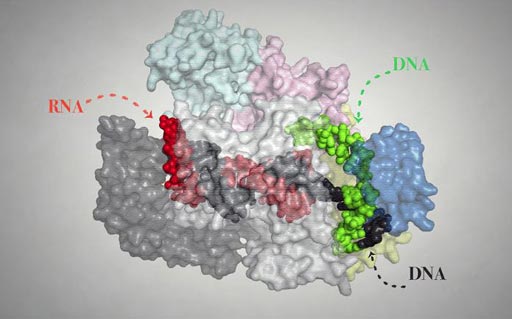Structural Analysis Explains Action of New Gene Editing Tool
By LabMedica International staff writers
Posted on 18 Jul 2017
An alternative approach for editing of double-stranded DNA may prove to be more versatile than the currently popular CRISPR/cas9 gene editing technique.Posted on 18 Jul 2017
CRISPR/Cas9 is regarded as the cutting edge of molecular biology technology. CRISPRs (clustered regularly interspaced short palindromic repeats) are segments of prokaryotic DNA containing short repetitions of base sequences. Each repetition is followed by short segments of "spacer DNA" from previous exposures to a bacterial virus or plasmid. CRISPRs are found in approximately 40% of sequenced bacteria genomes and 90% of sequenced archaea. CRISPRs are often associated with cas genes that code for proteins related to CRISPRs.

Image: A representation of the Cpf1 protein in complex with its target RNA and target DNA (Photo courtesy of the University of Copenhagen).
Since 2013, the CRISPR/Cas system has been used in research for gene editing (adding, disrupting, or changing the sequence of specific genes) and gene regulation. By delivering the Cas9 enzyme and appropriate guide RNAs into a cell, the organism's genome can be cut at any desired location. The conventional CRISPR/Cas9 system is composed of two parts: the Cas9 enzyme, which cleaves the DNA molecule and specific RNA guides (CRISPRs) that shepherd the Cas9 protein to the target gene on a DNA strand.
Investigators at the University of Copenhagen (Denmark) used X-ray crystallography to determine the mechanism underlying the action of Cpf1 (Centromere and Promoter Factor 1), an RNA-guided endonuclease that has emerged as a powerful genome-editing tool.
In the June 22, 2017, issue of the journal Nature the investigators provided insight into Cpf1's DNA-targeting mechanism by determining the structure of Francisella novicida Cpf1 with the triple-stranded R-loop generated after DNA cleavage. The structure revealed the machinery involved in DNA unwinding to form a CRISPR RNA (crRNA)-DNA hybrid and a displaced DNA strand.
Senior author Dr. Guillermo Montoya, professor in the protein structure and function program at the University of Copenhagen, said, "The main advantage of Cpf1 lies in its high specificity and the cleaving mode of the DNA, since it is possible to create staggered ends with the new molecular scissors, instead of blunt-ended breaks as is the case with Cas9, which facilitates the insertion of a DNA sequence."
Related Links:
University of Copenhagen









 assay.jpg)




